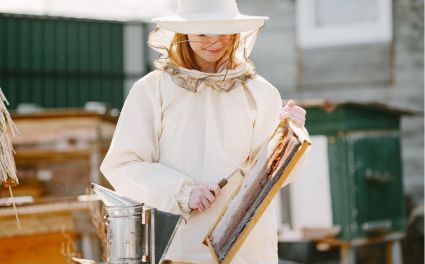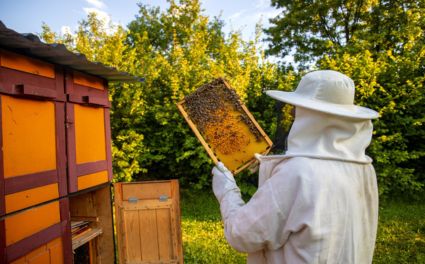Beekeeping can be a rewarding and fulfilling hobby, but let's face it - nobody wants to get stung by those little buzzing creatures! While bee stings are an inevitable part of being a beekeeper, there are strategies you can implement to minimize the risk and keep those pesky stingers at bay. In this blog post, we'll delve into the fascinating world of bees and explore techniques for preventing bee stings. So grab your protective gear and join us on this buzz-worthy journey towards happier and sting-free beekeeping!
Understanding Bee Behavior
When it comes to preventing bee stings, knowledge is power. Understanding how bees behave can help you anticipate their actions and minimize the chances of a sting. Bees are highly organized creatures that live in colonies, with each member playing a specific role.
Worker bees, for instance, are responsible for tasks such as collecting nectar and pollen, while the queen's sole purpose is reproductive duties. It's important to understand that bees only sting when they feel threatened or when their hive is attacked. One key aspect of bee behavior to keep in mind is their sensitivity to certain scents and movements. Bees have an acute sense of smell and can pick up on strong fragrances or sudden jerky motions. Avoid wearing heavily scented perfumes or lotions when tending to your hives, as these may trigger defensive reactions from the bees.
Additionally, abrupt movements near the hive can agitate the colony. When approaching your beehives, move slowly and deliberately, allowing the bees time to adjust to your presence without feeling threatened.
Also read: How does bee sting work?
Proper Protective Gear
When it comes to beekeeping, one of the most important aspects is wearing the right protective gear. Bees are known for their stingers; protecting yourself from potential stings should be a top priority.
A good quality bee suit is essential for keeping you safe during hive inspections and honey collection. This typically includes a full-body suit with zippered veil, gloves, and sturdy boots. The suit should fit snugly to prevent any gaps where bees could potentially enter.
The veil is crucial as it protects your face and neck from direct contact with bees. Opt for a veil made of fine mesh that allows good visibility while keeping those pesky insects at bay. Gloves are another must-have item in your beekeeping arsenal. Look for gloves for beekeepers, preferably ones that extend past the wrist area to provide maximum protection against stings.
While some experienced beekeepers may choose not to wear gloves or even use smoke during hive inspections, it's important to remember that safety should always come first – especially if you're just starting or dealing with more aggressive colonies. Investing in proper protective gear will give you peace of mind and allow you to focus on your tasks without constantly worrying about getting stung. So be sure to gear up before diving into your next buzzing adventure!
Gentle Hive Handling Techniques
When it comes to beekeeping, gentle hive-handling techniques are essential. Not only do they ensure the safety of both the bees and the beekeeper, but they also promote a harmonious relationship between the two.
It's important to approach your hive with a calm and steady demeanor. Bees are highly sensitive creatures and can pick up on any nervousness or aggression in their surroundings. You can help keep them at ease during inspections by maintaining a relaxed presence. Always use slow and deliberate movements when working with your hives. Sudden jolts or jerky motions can agitate the bees and increase the likelihood of stings. Take your time when removing frames or making adjustments within the hive – patience is key!
Another useful technique is using smoke to calm your colony before opening its hive. The gentle puffing of cool smoke helps mask alarm pheromones that may be released by guard bees when you disturb their home. Furthermore, avoid crushing or squishing any bees during inspections. This prevents unnecessary harm to individual bees and minimizes stress within the colony.
Make sure to reassemble your hive carefully after each inspection. Proper alignment of frames and boxes ensures that everything remains intact without pinching or injuring any inhabitants. By employing these gentle handling techniques in your beekeeping practices, you'll create a positive environment for yourself and your buzzing friends!
Timing and Weather Considerations
When it comes to beekeeping, timing and weather, play a crucial role in preventing bee stings. Bees are more likely to become agitated and defensive during certain times of the day and under specific weather conditions.
One important consideration is the time of day you work with your bees. Bees tend to be more docile in the early morning or late evening when less active. This is because their foraging activities are reduced during these periods, making them less defensive towards disturbances. Another factor to consider is the weather. Hot temperatures can make bees more irritable, especially if they feel threatened by nearby vibrations or sudden movements. On the other hand, cooler temperatures may cause bees to cluster together inside their hives, making them less likely to sting.
It's also essential to avoid working with your hives during rainy or windy conditions. Rain can agitate bees as they try to protect their hive from moisture, while strong winds can disrupt their flight patterns and increase their defensiveness. By carefully choosing the right timing and considering weather conditions before approaching your hives, you can significantly reduce the risk of bee stings for yourself and your precious honeybees.
Proper Beekeeper Attitude and Behavior
Beekeeping is not just about managing the hives and harvesting honey; it also requires a certain attitude and behavior from beekeepers. Your approach towards the bees can greatly influence their behavior, making it essential to maintain a positive and respectful attitude.
When working with bees, it's important to remain calm and relaxed. Bees are highly sensitive creatures that can detect fear or anxiety. By staying composed, you're less likely to provoke defensive responses from them. Respecting the bees' space is another crucial aspect of beekeeper behavior. Avoid sudden movements or loud noises near the hives, as these can agitate the bees. Remember that they are simply protecting their home and offspring.
Patience is key when handling beehives. Rushing through inspections or being rough with frames can increase aggression in the colony. Take your time and handle each frame carefully, ensuring minimal disruption for you and the bees. Maintain good hygiene practices while attending to your apiary. Bees have an excellent sense of smell, so avoid using strong-scented products like perfumes or colognes before tending to your hive.
Always be observant when working with your colonies. Pay attention to their body language – buzzing sounds, wing movement patterns – as these cues can indicate changes in temperament or potential issues within the hive. Adopting a proper beekeeper attitude and behavior establishes trust between yourself and your bees while minimizing stinging incidents on both ends.
Monitoring and Hive Management
One of the key aspects of successful beekeeping is regular monitoring and effective hive management. By closely monitoring your hives, you can identify potential issues before they escalate into major problems. Here are some strategies to help you monitor and manage your beehives effectively. It's important to regularly inspect your hives to ensure that the colony is healthy and thriving. This involves checking for signs of disease or pest infestations and assessing honey production and brood development. By doing so, you can take early action if any issues arise.
In addition to visual inspections, using tools like varroa mite monitoring boards or sticky traps can provide valuable information about the health of your hive. These tools help in tracking pest levels and enable timely treatment if needed. Another crucial aspect of hive management is maintaining proper ventilation within the hive. Adequate airflow helps regulate temperature and humidity levels, which is essential for bee health. Regularly cleaning out debris from bottom boards also aids in good ventilation.
Furthermore, managing available resources such as food supply is vital for sustaining a strong colony throughout the seasons. Monitoring honey stores ensures bees have enough food when nectar flow is limited. Consistent monitoring and proactive management techniques allow beekeepers to maintain healthy colonies while minimizing risks associated with diseases or pests.
Also read: Different types of honey
Conclusion
Beekeeping can be a rewarding and fulfilling hobby or profession, but it is important to prioritize safety and take the necessary precautions to prevent bee stings. By understanding bee behavior, wearing proper protective gear, practicing gentle hive handling techniques, considering timing and weather conditions, maintaining the right attitude and behavior as a beekeeper, and monitoring your hives regularly, you can minimize the risk of getting stung.
Remember that bees are not inherently aggressive creatures. They sting as a defense mechanism when they feel threatened or perceive danger. By respecting their space and working in harmony with them rather than against them, you can create a peaceful environment for yourself and your bees.
Implementing these strategies will not only help protect you from painful stings but also ensure the health and productivity of your colonies. Happy bees make for happy beekeepers! So put on that protective gear with confidence, approach your hives gently yet purposefully, keep an eye on weather conditions before diving into inspections or honey extraction sessions, and maintain a positive attitude toward your buzzing friends while being mindful of their needs through regular monitoring and management.



